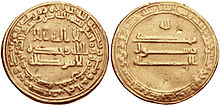Research center for Islamic numismatics
The Research Center for Islamic Numismatics in Tübingen, or FINT for short , is a scientific institution at the Eberhard Karls University of Tübingen . It was founded in 1990 and is part of the Department of Oriental and Islamic Studies at the Asia-Orient Institute. The affiliated collection of Islamic coins is by far the largest in Germany and one of the three largest and most important in the world.
The University of Tübingen bought the first around 700 Islamic coins in 1867; it was the collection of the folklorist and professor of oriental languages Ernst Heinrich Meier, who died in 1866 . After that, the holdings (which were quickly surpassed by other German collections) experienced neither an increase nor a scientific use for a long time; all that was done was new cataloging. The foundation for the establishment of the FINT was not laid until 1988, when the University of Tübingen, with the help of the Volkswagen Foundation, acquired the collection of Islamic coins from the American Stephen Album. At that time - especially after several trips to Iran and albums position in the coin trade, which enabled him to purchase numerous collections - this had grown to almost 30,000 pieces and thus the largest and best private collection in its field (among other things, the post-Reformation silver coins of the Umayyads and Coins from Yemen and Late Medieval / Early Modern Iran).

Prepared by the efforts of Professor Heinz Gaube from Tübingen (the only university lecturer in Germany who was certified as orient numismatic at the time) and the chromosome researcher Claus Pelling from the Max Planck Institute for Biology in Tübingen, the real history of FINT began with the appointment of its first head and collection curator , des Arabist and numismatist Lutz Ilisch , early 1990. The aim was to further develop the 37,000 coins - with the small old stock from the 19th century, the pieces from Album and the Ilisch collection, which has now been added as a deposit - and to use it as an archive for To permanently and intensively research the history of rule, religion and economy: A publication in Syllogeform , the inclusion of Islamic numismatics in the teaching at the Oriental Seminary, the inclusion of coin finds and the creation of city-related regent tables, the regular holding of specialist conferences and an acquaintance were determined making and making the collection available to the scientific public. For this purpose, in addition to a slide library (approx. 3000 image carriers) and a photo collection (approx. 5000 images), a dedicated, specialized reference and research library was set up, which is still supplemented today and in some cases contains very rare publications on Islamic numismatics.
Through targeted donations, the FINT coin collection under Lutz Ilisch's curation has been more than doubled over the years, to around 75,000 coins. If you also add the separate collection of classical archeology (see Numismatic Center ), Tübingen has the most extensive coin holdings of a German university. In the field of Islamic coins, only the collections of the Hermitage in St. Petersburg , the Qatar National Museum and the American Numismatic Society in New York City can compete with the FINT holdings worldwide. The latter includes properties from all regions from the Iberian Peninsula to India ; The aim is a systematic order according to mints .
The FINT collection is published in the series Sylloge Numorum Arabicorum Tübingen , in short: SNAT (by Ernst Wasmuth Verlag ). Some of the large-format volumes that have already served as models for other collections have been awarded international prizes for the best publication of the year. So far published:
- Vol. IVa Bilād aš-Šām I - Palestine , edited by Lutz Ilisch (1994)
- Vol. XIVd Ḫurāsān IV - Ġazna / Kabul , edited by Florian Schwarz (1995)
- Vol. IVc Bilād aš-Šām III - Ḥamāh , edited by Lorenz Korn (1998)
- Vol. XVb Central Asia II - North and East Central Asia , edited by Tobias Mayer (1998)
- Vol. XIVc Ḫurāsān III - Balḫ and the landscapes at the upper Oxus , edited by Florian Schwarz (2002)
- Vol. XVa Central Asia I - Buḫārā / Samarqand , edited by Boris Kočnev, Golib Kurbanov, Madeleine Voegeli and Michael Fedorov (2008)
- Vol. XIVa Ḫurāsān I - Naysābūr , Sabzawār and the mints in Ǧuwayn , edited by Atef Mansour M. Ramadan (2012)
- Vol. IVb1 Bilād aš-Šām II - Damascus from the Umayyads to the Mongols approx. 660–1260 AD , edited by Lutz Ilisch (2015)
- Vol. III Egypt , edited by Mohammad Younis (2017)
In addition to the SNAT publication, regular teaching and the support of research guests, who also come to FINT thanks to scholarships from the Middle East and Central Asia, Lutz Ilisch also worked on determining Islamic silver coins or dirham fragments, as shown in Germany can often be found in the ground east of the Elbe , see Viking Age coin finds in the Baltic Sea region . In addition, the Central European Regional Conference of the Oriental Numismatic Society (ONS) takes place every year at FINT .
After the research center, together with the library and collection, was housed in the building of the Tübinger Universitätskasse (Wilhelmstrasse 26) when it was set up in 1990, it moved to Wilhelmstrasse 113 in 2015, where the entire department for Oriental and Islamic Studies is located.
Individual evidence
- ↑ https://www.unimuseum.uni-tuebingen.de/de/sammlungen/muenzammlung-der-islamischen-numismatik.html
- ↑ http://www.universitaetssammlungen.de/sammlung/824
- ↑ http://wasmuth-verlag.de/herausgeber/forschungsstelle-fuer-islamische-numismatik-abteilung-fuer-orient-und-islamwissenschaft-aoi-der-universitaet-tuebingen/
- ↑ https://www.archaeologie-online.de/nachrichten/20-jahre-forschungsstelle-fuer-islamische-numismatik-tuebingen-1644/
Literature and web links
- Lutz Ilisch: “The Tübingen Collection of Islamic Coins” in: Stefan Heidemann (Ed.), Islamic Numismatics in Germany: An inventory , Otto Harrassowitz Verlag, 2000, ISBN 3447042699 , pp. 129-137.
- Literature from and about Research Center for Islamic Numismatics in the bibliographic database WorldCat
- FINT website
- https://www.unimuseum.uni-tuebingen.de/de/sammlungen/muenzammlung-der-islamischen-numismatik.html
- http://www.universitaetssammlungen.de/sammlung/824
